SpaceX Launches Falcon Heavy, Another Advance In The Space Race
Yesterday's Falcon Heavy Launch was a near-complete success and another amazing advance in the race to the stars.
Yesterday, SpaceX successfully launched its latest rocket, the Falcon Heavy, a rocket with roughly the same power as the legendary Saturn V rockets that sent men to the Moon during the Apollo program, on what was billed as a test flight but which also included a payload that included one of Elon Musk’s own Tesla automobiles with a “Starman” mannequin sitting in the driver’s seat:
KENNEDY SPACE CENTER, Fla. — From the same pad where NASA launched rockets that carried astronauts to the moon, a big, new American rocket arced into space on Tuesday. But this time, NASA was not involved. The rocket, the Falcon Heavy, was built by SpaceX, the company founded and run by the billionaire entrepreneur Elon Musk.
“It seems surreal to me,” Mr. Musk said during a news conference after the launch.
The launch of this turbocharged version of the workhorse Falcon 9 rocket, which has been carrying cargo to space for years, marks an important milestone in spaceflight, the first time a rocket this powerful has been sent into space by a private company rather than a government space agency.
The rocket carried a playful payload: Mr. Musk’s red Roadster, an electric sports car built by his other company, Tesla. Strapped inside the car is a mannequin wearing one of SpaceX’s spacesuits. They are expected to orbit the sun for hundreds of millions of years.
“It’s kind of silly and fun, but silly and fun things are important,” Mr. Musk said.
The success gives SpaceX momentum to begin developing even larger rockets, which could help fulfill Mr. Musk’s dream of sending people to Mars. To do that, he has described a new-generation rocket called B.F.R. (the B stands for big; the R for rocket) that might be ready to launch in the mid-2020s.
The near-flawless performance of the Heavy on Tuesday “gives me a lot of confidence we can make the B.F.R. design work,” Mr. Musk said.
He added that he hoped the launch would encourage other companies and other countries to aim for more ambitious goals in space.
“We want a new space race,” he said. “Races are exciting.”
Mr. Musk’s visions include humans living both on Earth and Mars. He’s part of a new generation of entrepreneurial space pioneers that includes Jeffrey P. Bezos, the founder of Amazon, who has said one of the goals driving his rocket company, Blue Origin, is the prospect of millions of people living in space. Planetary Resources, an American company with a large investment from Luxembourg, hopes to mine asteroids for profit. Moon Express, based in Florida, sees a business in providing regular transportation to and from the moon.
For now, the Heavy will enable SpaceX to compete for contracts to launch larger spy satellites, and some experts in spaceflight are encouraging NASA to use private rockets like the Heavy instead of the gigantic and more expensive rocket, the Space Launch System, that is currently being developed in part to take astronauts back to the moon.
“It basically gives them another tool in their toolbox for accomplishing the space community’s goals,” said Phil Larson, an assistant dean at the University of Colorado’s engineering school who previously worked as a senior manager of communications and corporate projects at SpaceX.’
Although delayed by high-altitude winds, the countdown proceeded smoothly, without any of the glitches that have bedeviled other maiden launches of new rockets.
The Heavy roared to life, a plume of smoke and steam shooting sideways from the launchpad. It rose from the pad, with an impossibly bright glare of 27 engines beneath it.
About 15 seconds later, a thunderous roar, traveling at the speed of sound, rolled over the spectators.
Just over three minutes after it blasted off, the most suspenseful part of the flight was over, as the boosters dropped off and the second stage continued into Earth orbit.
Some eight minutes after launch, a pair of sonic booms rocked the area as the two side boosters set down in near synchrony on two landing pads at Cape Canaveral. In the past few years, SpaceX has figured out how to routinely bring a booster stage back in one piece to fly again on future flights.
The one blemish on the mission was that the center booster, which was to set down on a floating platform in the Atlantic, slammed into the water instead, because some of the engines failed to ignite for the final landing burn.
Once in orbit, the rocket sent back video of the spacesuit-wearing mannequin in the car, with a hand on the steering wheel. On the dashboard were the words “Don’t Panic,” a nod to Douglas Adams’s book “The Hitchhiker’s Guide to the Galaxy.”
The spacecraft journeyed through Earth’s Van Allen radiation belt. About seven hours after the rocket took off, Mr. Musk announced that a third and final burn had put his sports car on an elliptical orbit away from Earth and around the sun that extends beyond Mars’s orbit.
Since 2010, the company has been sending the smaller Falcon 9 rocket into orbit, deploying satellites and carrying cargo to crews aboard the International Space Station. The company has disrupted the global launch business with its lower prices and reusable boosters.
The Falcon Heavy is capable of lifting 140,000 pounds to low-Earth orbit, more than any other rocket today. Because all three boosters are to be recovered to fly again, a Falcon Heavy launch costs not much more than one by the company’s existing rocket, Mr. Musk said. SpaceX lists a price of $90 million for a Falcon Heavy flight, compared with $62 million for one by Falcon 9, a bargain in the context of spaceflight.
Mr. Musk estimated that his company had spent more than half a billion dollars on Falcon Heavy and said that the program was almost canceled three times.
SpaceX has booked coming Heavy flights for Arabsat, a Saudi Arabian communications company, and the United States Air Force.
(…)
In addition to its central booster, the Falcon Heavy was equipped with two additional side boosters that essentially tripled its power at liftoff. While the Heavy uses many of the same components as the Falcon 9, Mr. Musk had cautioned that failures during a test flight would not be surprising. In particular, he worried about complex buffeting of air flowing past the boosters, which is difficult to predict even with the most sophisticated computer simulations.
The success of the Heavy could quell criticism that followed SpaceX’s first launch of the year — a Falcon 9 rocket that carried a highly classified payload code-named “Zuma,” on Jan. 7. A day after the launch, there were reports that Zuma had fallen back to Earth. SpaceX officials vociferously asserted that the Falcon 9 performed as expected, suggesting that blame for anything that went wrong should fall on Northrop Grumman, which built Zuma.
Here’s a video of SpaceX’s full coverage of yesterday’s launch, if you just want to see the launch and what followed that, you can fast-forward to the 20:00 minute mark, which is just about two minutes before launch:
Additioally, this video offers video of “Starman,” the driver of the Tesla that is now in an elliptical orbit around the Sun:
Watching the launch live over the SpaceX livestream was quite a thrilling experience even though it did fall short of actually being there. The launch itself was originally supposed to occur at 1:30 pm but was delayed twice due to wind shear in the upper atmosphere that would have had an impact on the fight as it proceeded upward. By 3:45 in the afternoon, though, the wind shear had cleared up and the launch was cleared to go. Even over the Internet, the roar of the engines was quite something, and watching the three-cored rocket clear the tower and roar into the atmosphere brought back memories of watching the first launches of the Space Shuttle era in the 1980s. Before the launch actually happened, though, SpaceX Founder Elon Musk admitted that there was at best a “fifty-fifty” chance that the launch would end in a spectacular failure just as some of the prior tests of the company’s less powerful Falcon 9 had in the early days. All of that was largely forgotten, though, once the rocket cleared the tower and ascended into the heavens. In seemingly perfect precision, the rocket went through each of its burns, and the separation of the individual launch vehicles, which consisted of two side cores and one center core, went off perfectly. If there was any disappointment, it was in the fact that the company was only able to recover two of the three rocket boosters that made up the rocket. The center core, which was intended to land on a floating platform in the Atlantic Ocean, missed its target. Nonetheless, despite that one failure, it seems fair to call the entire launch as a huge success and a massive advance forward for a company that has already revolutionized the private launch business and now seems destined to reach beyond the confines of Earth orbit.
As I’ve noted before the success of companies such as SpaceX and Blue Origin are evidence in favor of the argument that many people made in the wake of the end of the Space Shuttle program, namely that the nation was abandoning space exploration and placing its future in the hands of Russia and other nations. Instead what we have seen in the intervening years is something quite to the contrary. While SpaceX and its fellow private companies have concentrated their efforts on development of launch vehicles, NASA continues to pursue its own heavy launch vehicle that will send men back to the Moon and beyond, and the unmanned probes it has launched such and New Horizon, Juno, and Cassini, have sent back thrilling pictures and groundbreaking information regarding Pluto, Jupiter, and Saturn. Additionally, space telescopes such as Hubble and Kepler have provided us with new insights regarding the origins of the universe and the existence of Earth-like planets outside the Solar System. Rather than an abandonment of space, the last seven years have shown that both privately and publicly, the United States is still going strong in the space race and will be for a long time to come.
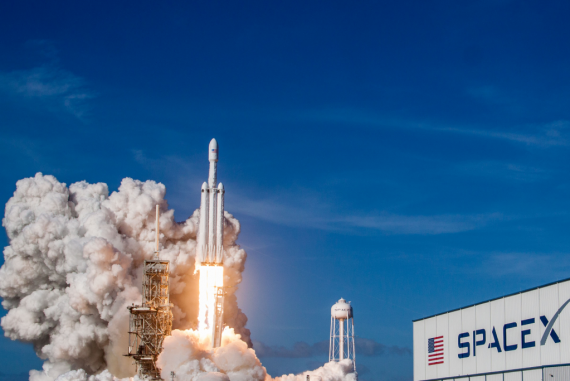

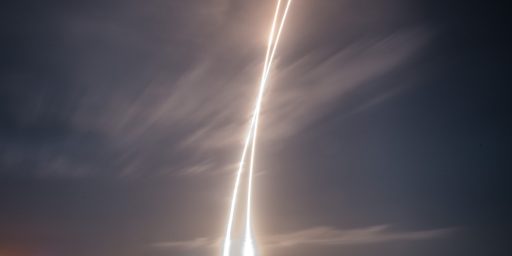
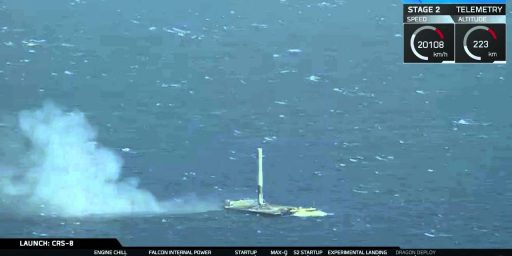
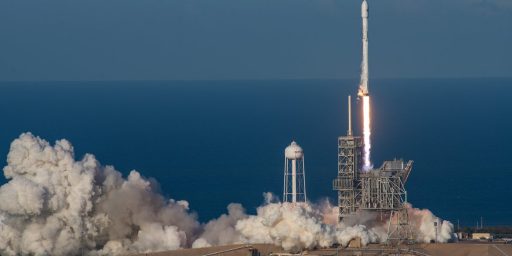
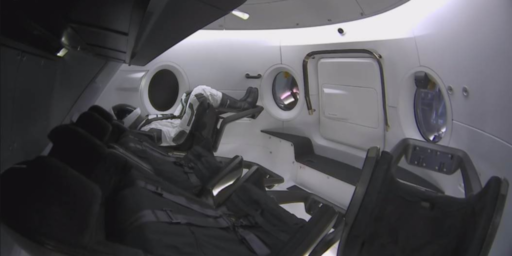
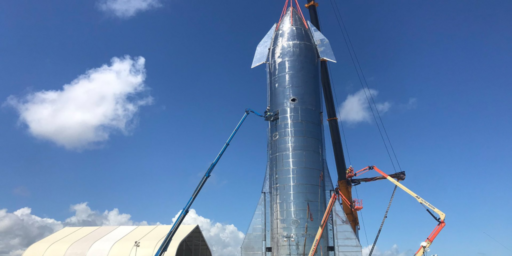
I think the aspect of this launch that gave me the most thrill was the simultaneous landing of the boosters. Looks like a good addition to the existing stable of rockets.
The costs seem to be reasonable for what I’ve seen. About $50M to build the Falcon Heavy with a charge of about $72M. That seems to be a lot cheaper than the Atlas and Delta rockets.
@Scott: Hell, yes! That synchronized booster landing was awesome.
I’m very impressed they kept 27 engines working in concert for the whole boost phase.
So, is SpaceX further along the path of missile development than North Korea?
Why are we not worried about private corporations with missile technology? Do we assume that they will never sell this technology, or that they are invulnerable to hacking?
Hats off to Elon Musk for making the intro to “Heavy Metal” a reality.
Original:
https://www.youtube.com/watch?v=DWMPe3wF9jQ
Updated animation:
https://www.youtube.com/watch?v=b8l121LGlWU
mashup:
https://www.youtube.com/watch?v=XT2HZEyJkVA
@Gustopher:
Change the channel, please
NASA is building a prototype that can get to the moon in thirty minutes.
Interstellar space travel is near.
I think the Tesla Roadster ploy is great. Very cool. But it leaves me wondering – what is in the trunk and the glove box?
I imagine that the glove box contains: A miniature combination Vulcan phrase book and Bible; $100 in Bitcoin; $100 in gold; 9 packs of chewing gum; one issue of prophylactics; 3 lipsticks; 3 pair of nylon stockings. Shoot, a fella’ could have a pretty good weekend in Vegas with all that stuff.
And the Trunk: The body of Jimmy Hoffa.
@JDM: Thank you, thank you for bringing to mind that amazingly hilarious scene in the movie Dr Strangelove in which the crew of the B-52 are inventorying their survival supplies – as if there was any reason to expect to survive a nuclear blast.
@JDM: @JDM: And what goes up in the next flight – a giant Coca Cola bottle circling the earth forever? Why must we commercialize and pollute everything we touch?
So the launch system developed by a private company is better and cheaper than the one being developed by a govt agency.
Go fig.
@TM 01: that’s one way of looking at it. But another way is to observe that many high risk, high reward ventures are initially funded by governments and then made available to private industry. Naval exploration (Columbus, Balboa, the search for reliable longitude), ultra wide area networking (the Internet), scientific breakthroughs that lead to world changing commercial projects (Fermilab, NHA grants, etc). construction techniques (suspension bridges), and, well, the list is long. But you would have to actually think beyond shallow slogans to understand such things.
@JDM: I was thinking more of the Repo Man Chevy Malibu.
Usually a new rocket will carry a dummy load, though typically something like steel, sand or concrete. People are reluctant to trust multi-million dollar satellites to unproven designs.
Spacex’s first rocket, the Falcon 1, did carry a satellite in the first test launch. The rocket blew up.
So, yeah, the red car with the dummy is a stand-in for sand bags. a publicity stunt not worth expending any synapses on.
@Kathy: But what a great publicity stunt! SpaceX and Tesla are commercial entities that pay for publicity in the form of advertising, and this was a freebie. I bet there will be decades worth of science fiction stories that feature this Roadster.
@MarkedMan: It reminds me of one of the most ridiculous scenes in “Voyager”, when they find a pick-up truck floating in space.
@TM 01: That private company which relies HEAVILY on NASA for support and technology. If NASA hadn’t already built the technology, knowledge base, and facilities then space x would of never gotten off the ground. Space X relied on NASA to figure out their explosion problem..